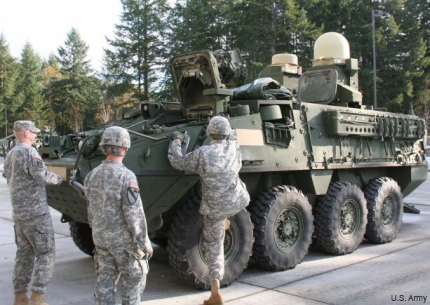Army command takes tactical network to the next level
The I Corps, which covers the Pacific theater, is using WIN-T Increment 2 to make Strykers into mobile headquarters.

A prototype Stryker was integrated with the WIN-T Point of Presence capability.
An Army operational command is testing an extension of its battlefield tactical network that can establish a mobile headquarters in Stryker armored vehicles.
The I Corps, which handles operations in the Pacific theater, is testing what it calls mission command on the move via the connectivity provided by the Army’s Warfighter Information Network-Tactical Increment 2 network, along with tactical data radios and Blue Force Tracking 2, which gives deployed troops information on the location of friendly and enemy forces.
"The proof-of-principle Strykers will allow corps leadership the ability to maintain their regular headquarters staff functions and enablers while in transit, and it's compressed into a design that will enable them to actually interact with the staff during battlefield circulation," Staff Sgt. Daniel Stack, I Corps G6 operational staff noncommissioned officer, said in a release. "They'll be able to communicate effectively and still be able to do things like PowerPoint, [just like he would at his desk at HQ]."
The Army began integrating the WIN-T Point of Presence capability into the rugged, maneuverable Strykers, which currently are not part of the I Corps’ regular equipment, at Joint Base Lewis McChord, Wash., in August and expects to be ready for operational exercises by January 2016. The system will give commanders advanced communications and a suite of command and control applications with near real-time situational awareness, the Army said.
"The I Corps proof-of-concept capability highlights the interoperability, scalability and flexibility of the Army's holistic network and mission command systems to support units at every stage of military operations, whether stationary or on-the-move, in a [tactical operations center] or en route in the heat of battle," said Lt. Col. Lamont Hall, product manager for WIN-T Increment 2.
The tests with the prototype Strykers represent another step forward in the Army’s efforts to extend battlefield command-and-control—including voice, data and video—to the field, with the eventual goal of getting a full situational awareness picture out to the squad level. WIN-T Increment 1 brought tactical communications to at-the-halt battalion level, such as a forward-deployed base. Increment 2 is taking it to the company level, with communications equipment mounted non vehicles such as Mine Resistant Ambush Protected vehicles, High Mobility Multi-purpose Wheeled Vehicles and Strykers.
The Army in June got the go-ahead to take Increment 2 into full-rate production and awarded General Dynamics a $219 million contract to deliver more than 300 vehicle-based nodes. Increment 3, which will extend communications further out into the field, is being developed under a contract to General Dynamics.
For now, the I Corps tests are forging a new frontier for Increment 2, which to date has not been fielded at the corps' headquarters level, which has used Increment 1 at stationary facilities.
"WIN-T Inc 2 will enable the corps to utilize the same mission command and communications capabilities found back at stationary headquarters facilities to conduct battlefield circulation and monitor successive decisive points on the battlefield during operations," Hall said.



